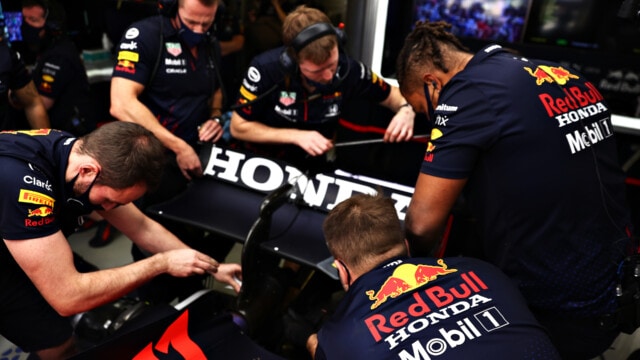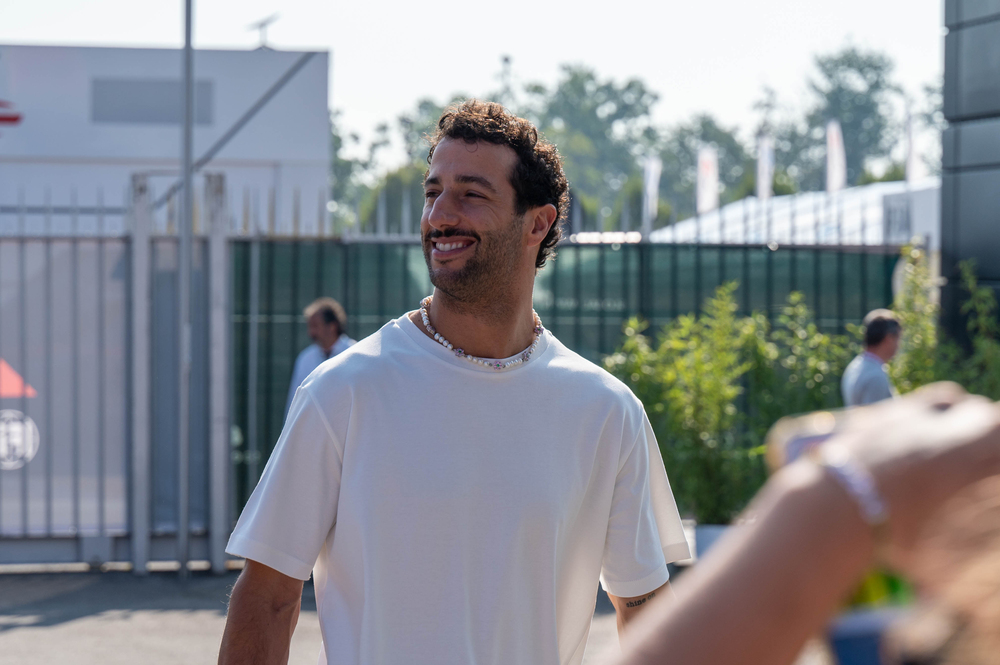When Can A Driver Use DRS During A Formula 1 Race? Understanding Activation Rules


The Drag Reduction System (DRS) is a mechanism in Formula 1 designed to bolster overtaking capabilities by decreasing a car’s aerodynamic drag. Debuting in the 2011 season, the system has contributed to more dynamic race strategies and elevated the potential for wheel-to-wheel racing. DRS operates through the adjustment of the car’s rear wing, which, when opened, reduces downforce and increases top speed, which is particularly useful on straights where high velocity is key and downforce is less critical.
During a Grand Prix, the activation of DRS is strictly governed. F1 Drivers can only engage DRS when they are within one second of the car in front of them at predetermined detection points on the race track, and subsequently when they reach the DRS activation zones. These zones are typically located on the straights, to afford drivers the best possibility for overtaking. The FIA regulates where these zones are placed, varying by circuit to reflect considerations such as safety and competitive fairness.
The employment of DRS is also conditional on environmental and race situations. For example, in the early stages of a race or during rainy conditions, the system is disabled to ensure driver safety. The reduction in downforce that DRS causes could jeopardize car control in wet conditions or in the initial laps when the field is densely packed.
Key Takeaways
- Facilitating Overtaking: DRS strategically reduces aerodynamic drag on straights, aiding in overtaking maneuvers by increasing top speed.
- Condition-Dependent Activation: Drivers can engage DRS when within one second of the car ahead in designated zones, with usage governed by specific rules to maintain safety and sporting fairness.
- Strategic Racing Element: The presence of DRS adds a layer of strategy, as drivers and teams must navigate its activation conditions to gain competitive advantages while also considering tire wear and fuel management.
- Safety Regulations Compliance: DRS usage is subject to safety regulations, including restrictions during wet conditions and the initial laps of the race, ensuring the system’s benefits do not compromise driver safety.
- Dynamic Racing Dynamics: DRS can lead to ‘DRS trains’, affecting the race’s dynamics by providing following cars with speed advantages, which can alter defensive and offensive strategies throughout a Grand Prix.
DRS Activation Conditions
DRS, or the Drag Reduction System, provides a significant speed advantage when overtaking. Activation is subject to strict conditions during races, focusing on the proximity to other cars and certain phases of the race.
Eligibility Criteria for DRS Use
The principal criterion for using DRS is the proximity of the following car to the car ahead. In a race situation, the driver must be within one second of the car in front at predetermined ‘detection’ points on the track. If the gap is less than one second, the system enables the driver to activate DRS.
Additionally, DRS use is prohibited in the first lap after the start or a restart, including following safety car periods. Should the track conditions be declared wet by the race director, the use of DRS is typically prohibited for safety reasons. Other eventualities that may lead to DRS deactivation include incidents like on-track debris or a car leaving the track in the DRS zone.
Timing and Location for Activation
DRS can only be activated in specified segments of the track, known as ‘Activation zones.’ These zones are usually situated in areas leading up to long straights to maximize the benefit of increased top speed for the following car.
Activation Zones typically include:
- Each circuit’s main straights where overtaking is likely
- Certain circuits may have additional zones designed to aid overtaking in areas with historically low passing rates
The exact location of these zones, including where they start and end, are determined by the race governing body, the FIA, and vary for each track. The timing for the DRS is regulated by a detection point, where the one-second gap is measured just before the activation zone. If the following driver is close enough at this point, they receive a confirmation, often via dashboard notification, that authorizes them to open the rear wing flap upon entering the DRS zone.
Understanding DRS Functionality
The Drag Reduction System (DRS) is critical for enhancing overtaking opportunities in Formula 1. By mastering the operational nuances and the effect it has on a car’s velocity, we can appreciate how DRS shapes the dynamics of a race.
How DRS Works
DRS enables Formula 1 drivers to reduce aerodynamic resistance by manipulating the car’s rear wing. Activating DRS opens a flap, which allows for a temporary reduction in drag. This is controlled by the driver, usually by pressing a button on the steering wheel, but it can only be utilized within predefined track sections known as ‘Activation’ zones.
Technical Details of DRS Operation
DRS Activation Mechanism:
- Flap Adjustment: A centrally located actuator changes the angle of the rear wing flap.
- Control: Drivers engage DRS via a steering wheel button.
- Limitations: DRS use is restricted to within designated ‘Activation’ zones and when the driver is less than one second behind a competitor.
- Timing Measures: Electronic loops track the gap between cars for DRS eligibility.
- Practice and Qualifying: Unrestricted DRS use, but confined to specific zones.
Impact on Car’s Speed and Overtaking
DRS significantly affects a Formula 1 car’s speed by slashing downforce, thus improving straight-line pace. This increase in velocity is intended to help drivers approach and surpass competitors, vitalizing the racing experience. While this system is pivotal for overtaking, it also introduces strategic complexity to racing, as teams and drivers must judiciously select moments for DRS use—balancing speed gains with potential impacts on tire wear and overall race strategy.
DRS Zones and Their Significance
DRS zones are pivotal in Formula 1, influencing overtaking opportunities and racing dynamics.
Designation and Location of DRS Zones
DRS zones are specific parts of the track chosen by the FIA where drivers can deploy the Drag Reduction System. Drivers may activate DRS within these zones if they are within one second of the car ahead at the designated detection point. Each track has one or more DRS zones, usually located on long straights to maximize the benefit of reduced aerodynamic drag.
DRS Zones Impact on Racing Strategy
The presence of DRS zones substantially affects a team’s approach to the race. Teams calculate optimal approaches to these zones for attacking or defending positions. Furthermore, they incorporate DRS into their simulations to inform strategy decisions, such as pit stops or tire management, knowing that the system can play a role in facilitating overtaking maneuvers and influencing a race’s outcome.
Safety and Regulation Compliance
Safety considerations and adherence to regulations are pivotal in the use of the Drag Reduction System (DRS) during Formula 1 races. Changes to the locations of DRS zones for safety reasons can happen even between the practice sessions and the race itself.
DRS Usage Restrictions for Safety
- Activation: Drivers are permitted to activate DRS only when they are within one second of the car ahead at the detection point.
- Conditions: Use of DRS is prohibited during the first lap of the race and for two laps after a restart, though there may be exceptions reducing this interval to one lap based on specific race rules.
- Location: DRS zones are strictly defined by the FIA and are the only sections on the track where the system can be employed.
Safety restrictions are a protective measure to prevent high-speed accidents, especially in tight corners or hazardous track sections.
Strategic Implications of Safety Limitations
- Driver Strategy: Pilots must consider the safety limitations of DRS usage as part of their race tactics, particularly when positioning their vehicles to optimize DRS use.
- Team Decisions: Teams must adjust strategies based on DRS availability, which can be influenced by safety car periods altering normal DRS usage periods.
The limitations on DRS ensure that the system is used in a controlled manner, balancing speed advantages with the necessity to maintain a safe racing environment.
Analysis of DRS in Racing Dynamics
This section examines the strategic use of the Drag Reduction System (DRS) and its influence on race tactics and competition within Formula 1.
DRS Trains and Their Effects
A “DRS train” occurs when multiple cars within the DRS activation zone form a line, each waiting for an opportunity to use the system to overtake. In this situation, the leading car that cannot benefit from DRS is at a distinct disadvantage, as all following cars can potentially close the gap and attempt an overtake. This can lead to a tactical game where drivers aim to stay within the one-second window to the car ahead, allowing them to access DRS down straights for both defensive and offensive maneuvers.
- Primary effects of DRS trains include:
- Defensive Positioning: Drivers may adjust their tactics, either pushing harder or conserving tyres, to avoid falling out of the DRS window.
- Overtaking Opportunities: Those within the window may use DRS to attempt overtakes, leading to more dynamic races.
Advantages and Critiques of DRS
Advantages of DRS include its contribution to overtaking, making races more engaging for viewers. DRS can aid in compensating for the loss of downforce experienced when following another car closely, thus promoting closer racing.
- Advantages outlined:
- Increased Overtaking: DRS helps drivers overcome the aerodynamic disadvantages of following another car closely.
- Race Strategy: Teams must develop strategies considering DRS zones, potentially leading to varied tactical approaches.
Criticism surrounds the notion that DRS can make overtaking too simple, thereby reducing the skill required to pass. Some argue it artificially alters racing outcomes and can lead to less “pure” racecraft.
- Key criticisms highlighted:
- Artificial Racing: Detractors claim DRS detracts from the driver’s skill in overtaking.
- Predictable Outcomes: Repeated DRS-assisted overtakes can lead to predictable racing scenarios, with less emphasis on driver ingenuity.





